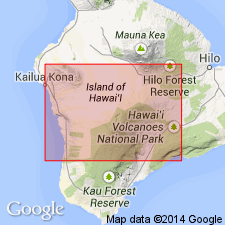
- Usage in publication:
-
- Pahala series
- Modifications:
-
- Named
- Dominant lithology:
-
- Ash
- Basalt
- AAPG geologic province:
-
- Hawaii
Summary:
Named for Pahala [village] on SE slope of Mauna Loa, Island of Hawaii. Author cites [unpublished?] reports on water supply by W.O. Clark and L.F. Noble (1920) who divided lavas into 3 series: pre-Pahala, Pahala, and post-Pahala series. Pahala series is characterized by thick beds of yellow ash interbedded with lava flows (medium to light bluish rocks lacking pinkish tints of pre-Pahala rocks and darker than pre-Pahala lavas [Ninole basalt]. Thickness probably over 300 ft. Unconformably overlies pre-Pahala series [Ninole basalt].
Source: GNU records (USGS DDS-6; Menlo GNULEX).
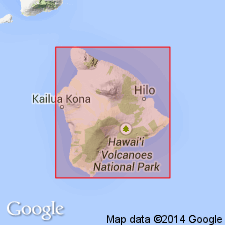
- Usage in publication:
-
- Pahala basalt*
- Modifications:
-
- Redescribed
- AAPG geologic province:
-
- Hawaii
Summary:
Adopted Pahala basalt of the district of Kau on Mauna Loa and Kilauea Volcanoes on Island of Hawaii. Includes 55 ft bed of volcanic ash. Overlies with erosional unconformity Ninole basalt and underlies Kamehame basalt. Assigned Pleistocene(?) age.
Source: GNU records (USGS DDS-6; Menlo GNULEX).
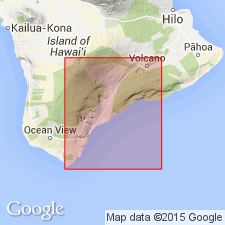
- Usage in publication:
-
- Pahala ash
- Modifications:
-
- Revised
- Redescribed
- AAPG geologic province:
-
- Hawaii
Summary:
[Here restricted to ash deposits] of Pahala basalt which are renamed Pahala ash. Comprised of yellow ash upper layer and thin-bedded gray ash lower layer. Exposed on Mauna Loa slope and Kilauea to Ka Lae. Kilauea Volcano considered probable source of ash. Is as much as 95 ft thick in scarp back of Kapapala half-way house.
Source: GNU records (USGS DDS-6; Menlo GNULEX).
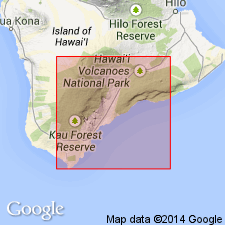
- Usage in publication:
-
- Pahala basalt*
- Modifications:
-
- Overview
- AAPG geologic province:
-
- Hawaii
Summary:
Also refers to unit as "Pahala formation". Best exposure of unit occurs at Kahuku escarpment of over 1000 ft. Best exposure of ash member is at Puu Enuhe. Is 30 to 55 ft thick at top of unit which in places is separated into two or more beds by intercalated lava flows. Geologic map of part of Kau district shows unit and member undivided. Age is Pleistocene(?).
Source: GNU records (USGS DDS-6; Menlo GNULEX).
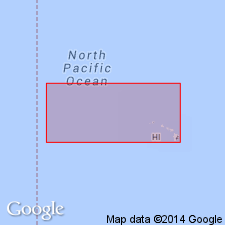
- Usage in publication:
-
- Pahala tuff
- Modifications:
-
- Redescribed
- Areal extent
- AAPG geologic province:
-
- Hawaii
Summary:
Name changed to Pahala tuff for beds of palagonitic material which are interbedded with or lie at top of basalts of Pahala formation of Stearns and Clark (1930). Extends over areas near Pahala, 21 mi SW of Kilauea (Kilauea, Pahala, Honuapo, and Kalae 7.5' quads); also in Glenwood district, Kapukapu, Kaone and other localities near Kilauea and at Kalae. Measured sections are described and possible secondary eolian origin for parts of tuff is discussed. Mauna Kea Volcano considered probable source.
Source: GNU records (USGS DDS-6; Menlo GNULEX).
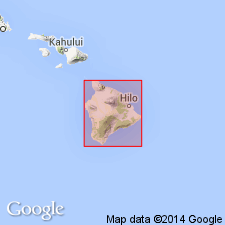
- Usage in publication:
-
- Pahala ash*
- Modifications:
-
- Age modified
- Areal extent
- AAPG geologic province:
-
- Hawaii
Summary:
Pahala basalt originally included lavas from both Mauna Loa and Kilauea. Name "Pahala ash" now restricted to ash capping Hamakua volcanic series on Mauna Kea Volcano (including Waiau tuff of Wentworth, 1938), Kahuku volcanic series on Mauna Loa Volcano, Hilina volcanic series on Kilauea Volcano, Hawi volcanic series on Kohala Mountain and Weawea volcanics in Hualalai (coating only). Is composite subaerial ash deposit from 4 volcanoes, Mauna Kea, Mauna Loa, Kilauea and Kohola. Crops out approx. 450 sq mi. Ranges in thickness up to 55 ft. Underlies Puna volcanic series on Kilauea, Laupahoehoe volcanic series on Mauna Kea, Kau volcanic series on Mauna Loa. Assigned Pleistocene age based on relationship to lithified calcareous sand dunes formed during low stand of sea.
Source: GNU records (USGS DDS-6; Menlo GNULEX).
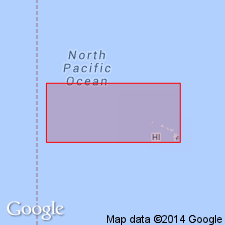
- Usage in publication:
-
- Pahala ash*
- Modifications:
-
- Overview
- AAPG geologic province:
-
- Hawaii
Summary:
Traces usage of name by previous authors. Described as vitric ash, largely palagonitized, generally well bedded, containing many recognizable fragments of pumice and other lava fountain debris. Overlies lavas of Kahuku, Hilina, Hamakua, Hawi and part of Hualalai volcanic series; underlies Kau, Puna, and Laupahoehoe volcanic series. Occurs in windows in Kau volcanic series on Mauna Loa and in Puna volcanic series on Kilauea. No fossils. Assigned Pleistocene age.
Source: GNU records (USGS DDS-6; Menlo GNULEX).
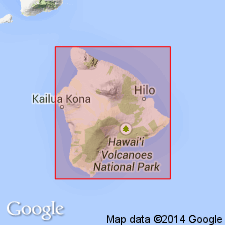
- Usage in publication:
-
- Pahala ash*
- Modifications:
-
- Overview
- AAPG geologic province:
-
- Hawaii
Summary:
Unit originally at least 10 ft thick in area of 2000 sq mi in SE half of Island of Hawaii; S and SW of Kilauea Caldera was 100 ft thick. Pahala ash is only bed in Hawaiian Islands that is thick and extensive enough to be used for stratigraphic correlation on more than one volcano.
Source: GNU records (USGS DDS-6; Menlo GNULEX).
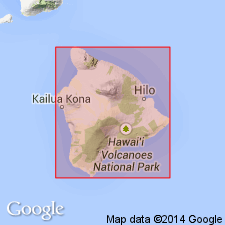
- Usage in publication:
-
- Pahala ash*
- Modifications:
-
- Paleomagnetics
- AAPG geologic province:
-
- Hawaii
Summary:
Age considered late Pleistocene and Recent based on normal magnetization of samples collected below and above unit.
Source: GNU records (USGS DDS-6; Menlo GNULEX).
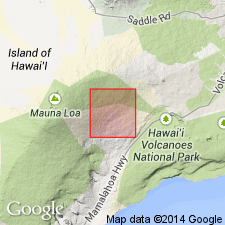
- Usage in publication:
-
- Pahala ash*
- Modifications:
-
- Age modified
- AAPG geologic province:
-
- Hawaii
Summary:
Mapped with cross section in Kupuka Pakekake 7.5' quad, Island of Hawaii. Pahala ash outcrops at S boundary of quad 2 mi W of SE corner. Rests on subsurface lava flows of Kahuku volcanic series. Cross section shows unit to be overlain by Kau volcanic series in SE corner. Assigned prehistoric Quaternary age. [no basis given]
Source: GNU records (USGS DDS-6; Menlo GNULEX).
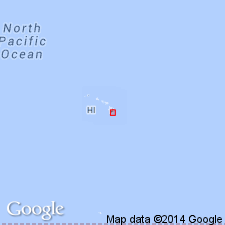
- Usage in publication:
-
- Pahala Ash*
- Modifications:
-
- Geochronologic dating
- AAPG geologic province:
-
- Hawaii
Summary:
"Can be viewed as a sequence of weakly developed paleosols". Has been assigned late Pleistocene age based on C-14 ages. Age of 10,140 +/-300 yr B.P. has been obtained from carbonaceous ash of uppermost beds and one of 17,360 +/-360 yr B.P. has been obtained from carbon in lower part (Rubin and Berthold, 1961).
Source: GNU records (USGS DDS-6; Menlo GNULEX).
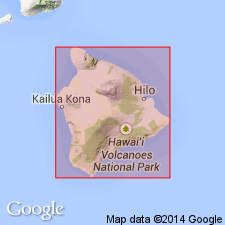
- Usage in publication:
-
- Pahala Ash*
- Modifications:
-
- Geochronologic dating
- AAPG geologic province:
-
- Hawaii
Summary:
Carbon-14 ages of 31.1 +/-0.9 ka has been reported for charcoal roots from base of Pahala Ash on Moana Loa Volcano (Kahukupoko Point, Naalehu 7.5' quad, 19 deg 04' 27"N, 155 deg 33' 40"W).
Source: GNU records (USGS DDS-6; Menlo GNULEX).
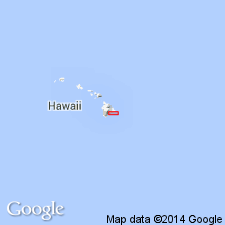
- Usage in publication:
-
- Pahala Ash*
- Modifications:
-
- Principal reference
- AAPG geologic province:
-
- Hawaii
Summary:
Principal reference section at Mooleo, Hilina Pali (19 deg 17' 00"N, 155 deg 19' 00"W, Kau Desert 7.5' quad) Kilauea Volcano, Island of Hawaii, HI. Also reference sections at Puu Kapukapu (19 deg 16' 15"N, 155 deg 17' 15"W, Kau Desert 7.5' quad) and at Puu Kaone (19 deg 16' 15"N, 155 deg 17' 15"W, Kau Desert 7.5' quad0. Puna Basalt lava flows are interbedded or overlie Pahala Ash at Puu Kaone, Puu Kapakapu and in places along Hilina Pali.
Source: GNU records (USGS DDS-6; Menlo GNULEX).
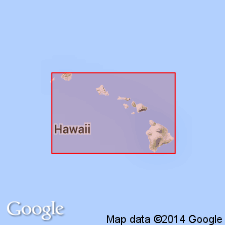
- Usage in publication:
-
- Pahala Ash*
- Modifications:
-
- Areal extent
- AAPG geologic province:
-
- Hawaii
Summary:
Geographically restricted to occurrences on Kilauea and Mauna Loa Volcanoes, Island of Hawaii. Current mapping on Mauna Kea, Hualalai, and Kohala indicates that extensive surficial ash deposits on these volcanoes are locally derived and are genetically distinct from Pahala Ash on Kilauea and Mauna Loa (E.W. Wolfe, oral commun., 1986).
Source: GNU records (USGS DDS-6; Menlo GNULEX).
For more information, please contact Nancy Stamm, Geologic Names Committee Secretary.
Asterisk (*) indicates published by U.S. Geological Survey authors.
"No current usage" (†) implies that a name has been abandoned or has fallen into disuse. Former usage and, if known, replacement name given in parentheses ( ).
Slash (/) indicates name conflicts with nomenclatural guidelines (CSN, 1933; ACSN, 1961, 1970; NACSN, 1983, 2005, 2021). May be explained within brackets ([ ]).

